
|
 Downloads
Downloads
|
 Prices
Prices
|
 Videos
Videos
|
GeolOil - What's new : Major Software Releases
Following down is a list of some stable versions released. Please make sure you always have the latest version installed.
-
2026 January 02
The 2026 release improves RAM management. However, handling very large log files and processing multiple logs simultaneously still benefits from having a large amount of RAM.
-
2025 November 04
Two new workflow functions were added to GeolOil:
1) A three points piece-wise linear calibration (function 8 below), and
2) The computation of semi-extreme curves between two curves (function 9):
The log-plot below shows a shale-oil reservoir for which two algorithms for Volume of kerogen were computed. Occasionally, the version 1 red curve 14:Vker_vers1 is larger (yellow filling) than the blue curve 15:Vker_vers2, but not always (blue filling). Neither the calculation of the average curve, nor the calculation of the minimum or maximum curves seemed appropriate for this reservoir. Instead, the final estimation for the volume of kerogen, was selected as a semi-minimum between the two curves, using a balance parameter of Ω=-0.5 (the dashed maroon curve 16). This yields a non completely pessimist result, slightly biased to the minimum.

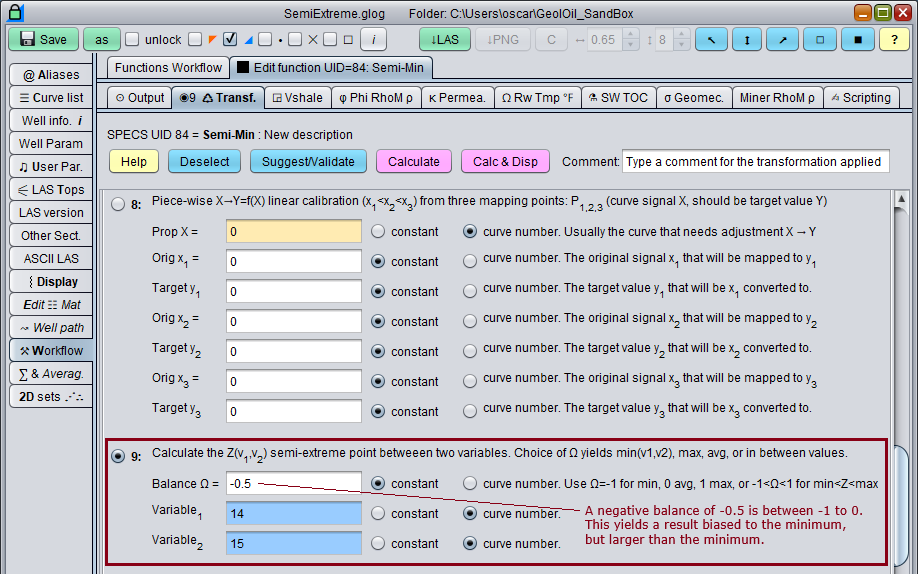
-
2025 October 20
GeolOil detects repeated (identical) log curves, and sorts stratigraphy table.
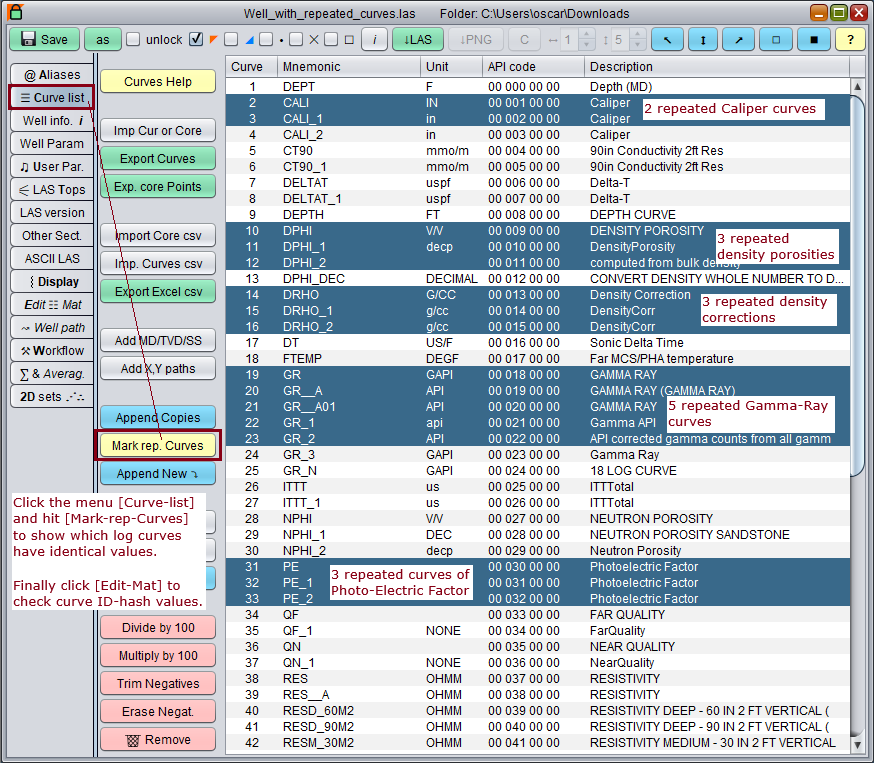
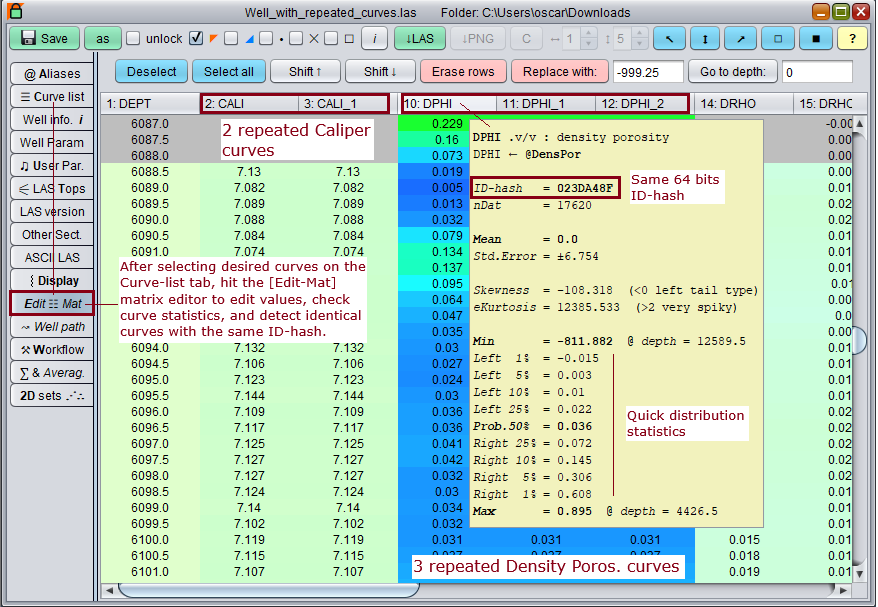
-
2025 September 17
GeolOil has been migrated to Java-25, while keeping legacy compatibility with Java-17 and beyond.
-
2025 June 25
GeolOil enables to dim individual tracks between a top and a base, by putting a translucent glass on top of it. One typical use is to highlight several track zones as unreliable: The well below, in the zone between marks A and B, had presence of barite. This caused an incorrect, higher reading of the photoelectric curve PEFZ, which lead to the overestimation of dolomites on the mineral solver track.
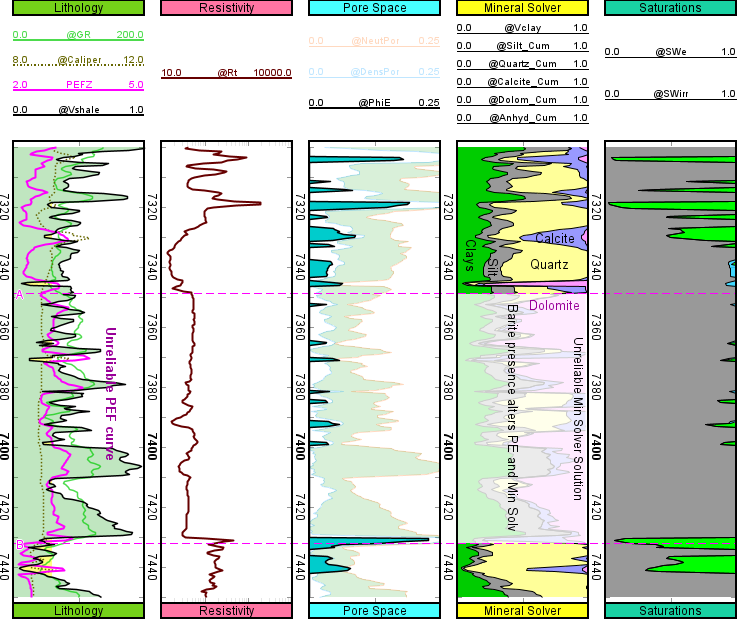

-
2025 March 25
GeolOil has been migrated to Java-24, while keeping legacy compatibility with Java-17 and beyond.
-
2024 July 27.
Build version Sha1 ID = F64115
GeolOil can run now on logs with an extreme high resolution, even with 1 centimeter of depth step. So it is ideal to be used on shallow geo-thermal projects, or to study metal caliper corrosion. This new version has been verified also to run seamlessly on the latest Java-22 version.
-
2024 March 17.
Build version Sha1 ID = 04EACD
User parameters and LAS Tops, can be simply entered now on any box constant function or script, by prepending its keyword with the sigil % For instance, type in a box %Salinity, and it will retrieve its value of say 43,000 PPM NaCl from the User Parameters section table:
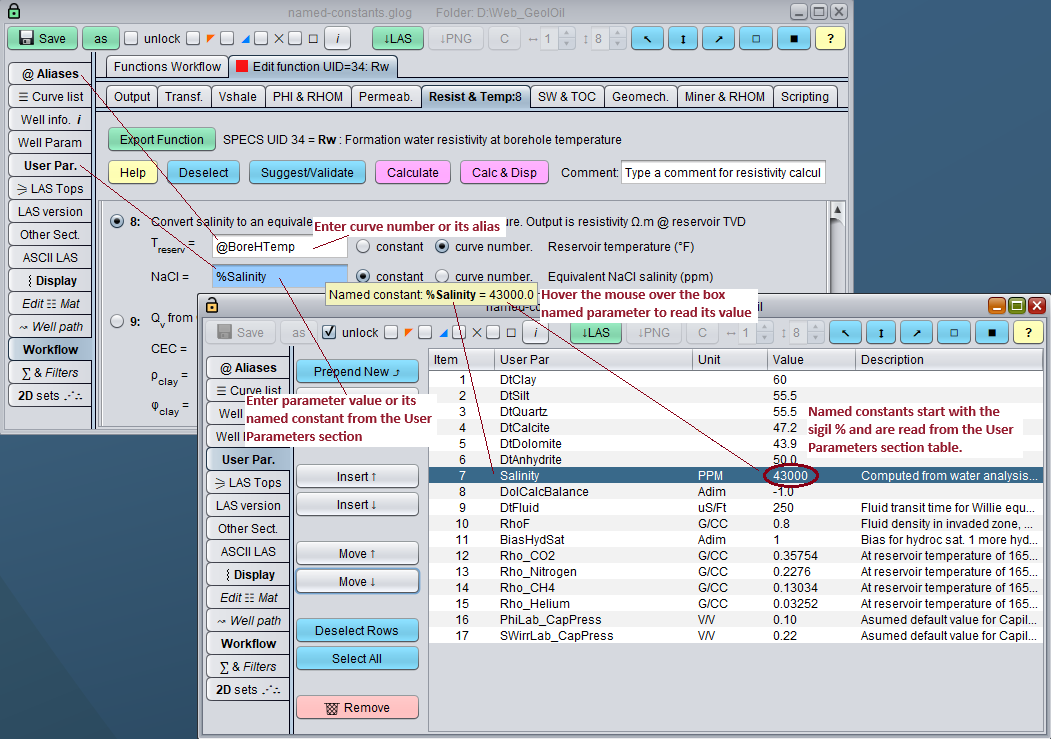
-
2024 March 08.
Build version Sha1 ID = 873C5C
This release implements the Nugent equation to estimate the porosity cementation exponent m in buggy carbonate rocks. Not be confused with the Rasmus equation to estimate fracture porosity. The rock must be buggy for the equation to be applicable.
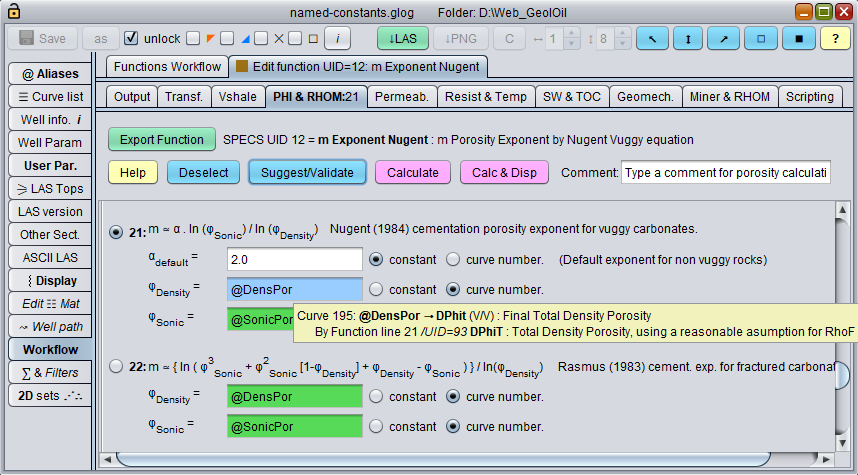
-
2024 February 05.
Build version Sha1 ID = 44948A
GeolOil adds a built-in function to estimate effective porosity in water bodies from deep resistivity only. As soon as a water body like a water pocket or an aquifer is detected in the formation, the method provides a reliable alternative method to estimate porosity. Of course, an accurate estimate of Rw is needed. I also other source curves like bulk density, neutron porosity, or sonic transit time are available, the method allows to validate and compare several estimates. The technique is reliable in water zones. For pay zones, the estimated porosity is severely under-estimated, as seen on the log-plot below after the computation panel.
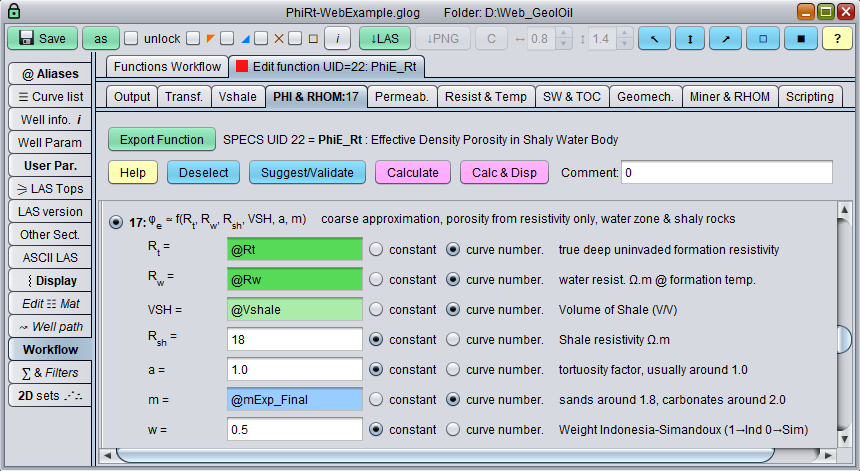
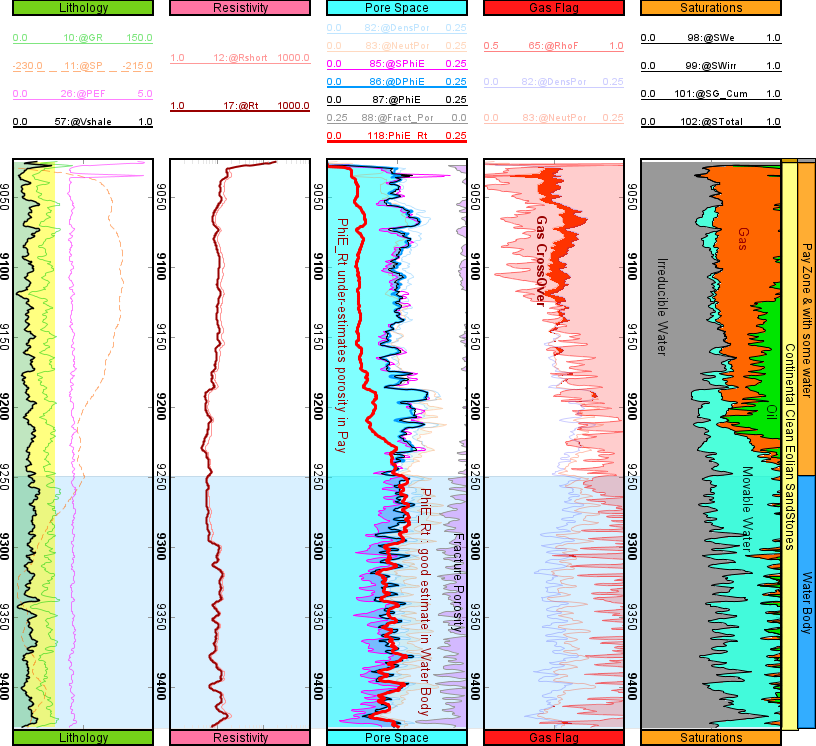
-
2024 January 15.
Build version Sha1 ID = CAAF97
This release implements the computation of the effective porosity in shaly sands from Rxo invaded flushed zone resistivity.
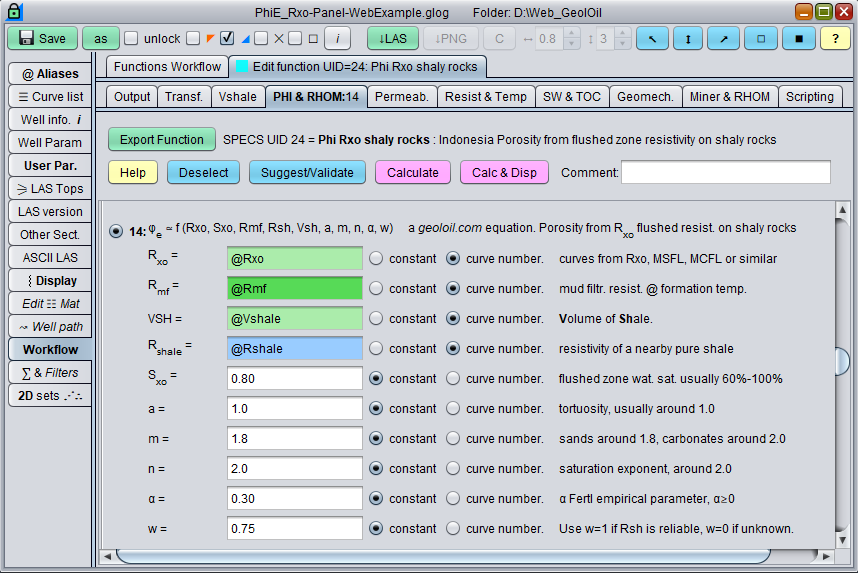
-
2023 November 29.
Build version Sha1 ID = 6CA65C
This release implements the computation of the m porosity cementation exponent for shaly sands, using the GeolOil-Pickett modified equation. The method has a general applicability, and reduces to the standard Pickett plot equation for clean rocks when Vshale=0.

-
2023 November 06.
Build version Sha1 ID = B1C9BE
The tab 2D sets ⋰∴ shows all the Pearson linear correlation coefficients between curves. Just hover the mouse on a selected curve to show all the r correlations with the remaining curves.
The figure below shows (the beige panel) the correlations in a gas reservoir between its gas saturation SG and other curves. For instance, the linear correlation between the gas saturation SG and the oil saturation SO is r=-0.7917. That is, there is a trend that if the gas saturation decreases, the oil saturation increases. And that is consistent with a negative correlation with depth, as r=-0.3999 is negative, so the deeper the depth, the smaller the gas saturation, as expected for a gas reservoir.
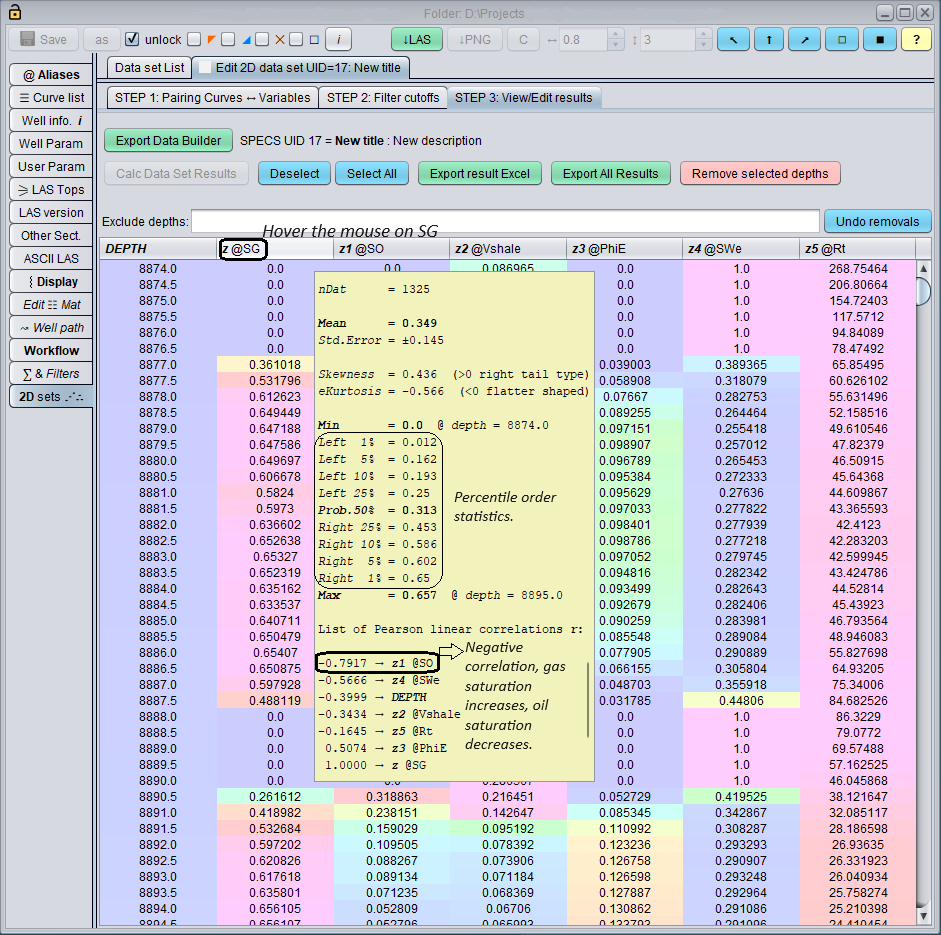
-
2023 October 01.
Build version Sha1 ID = 8297B1
A dedicated brand new section ~User Parameters has been added to store user defined constants and parameters. Now there is no need to add them to the original read source ~Parameters of the well. Yet it keeps the same syntax to refer values. For instance, %RhoF refers below to the constant value of 0.80 grams/cm3 for the fluid density around the wellbore wall with a mix of mud and gas in a gas reservoir.
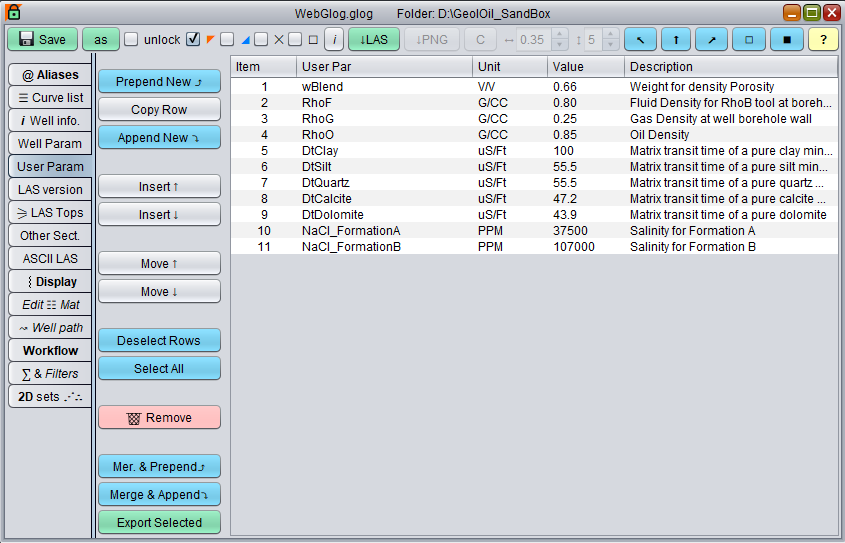
-
2023 September 07.
Build version Sha1 ID = 03305F
GLS Script compiler now allows to specify constants from the LAS & GLOG Sections: ~Parameters, ~Well info, and even the non-standard (but recommended) ~Tops section. For instance, if formation water Salinity has a value of 35,000 NaCl PPM, it can be referred anywhere in a script by prepending its keyword with the Sigil "%": %Salinity will behave then like a variable with a constant value of 35000 for all log depths.
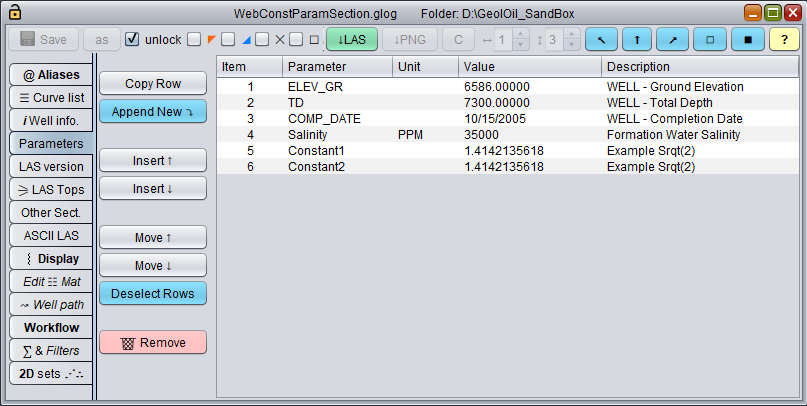
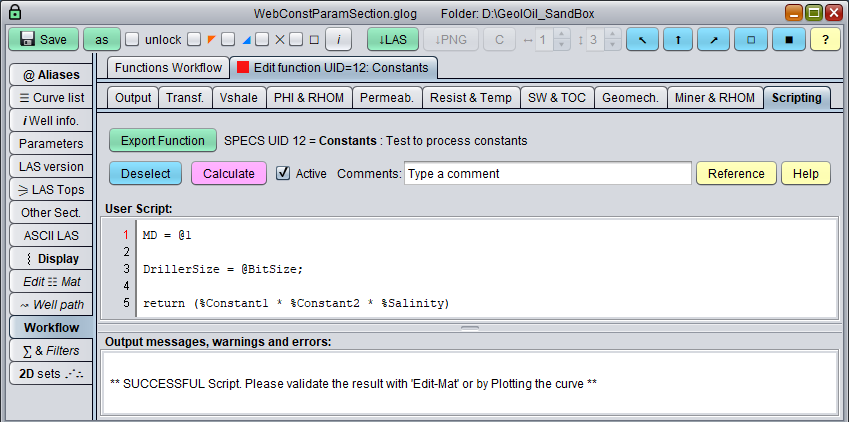
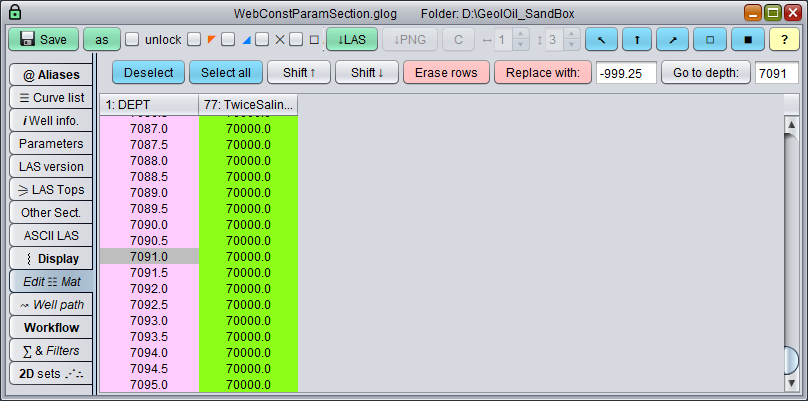
-
2023 June 07.
Build version Sha1 ID = A4448F
Fixed minor regression bug when importing stratigraphy that modified the current well path.
-
2023 April 09.
Build version Sha1 ID = EAEE48
Improvements to the Alias Editor includes better detections of malformed aliases and repeated aliases. These cases are now marked as unactive aliases.
-
2023 February 26.
Build version Sha1 ID = 291CF9
All GeolOil models come with a double split window viewer of raster well logs, so you can visualize curve leyends, strokes, and scales together with curve plots, or compare two zones. No matter how large would be the raster TIFF files (or other image formats, like JPG, PNG, GIF, or BMP), you will be able to load and view several well raster files in the application besides other windows of workflows.
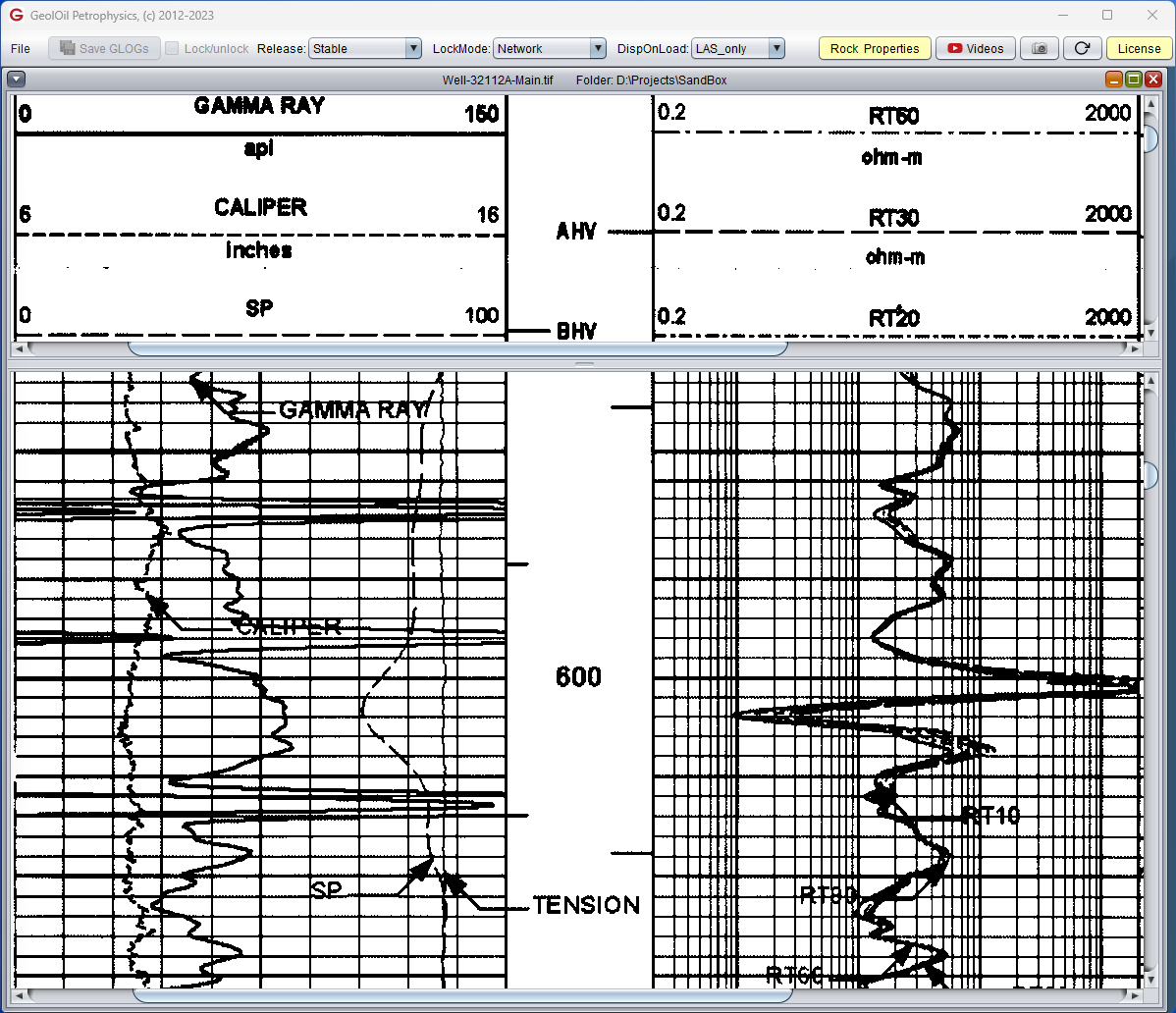
-
2023 February 12.
Build version Sha1 ID = 12B285
Backwards compatibility with legacy Java versions 8 to 16, has been removed. GeolOil now requires Java versions 17, 18, or 19. These modern versions of Java improve performance, features, and safety.
-
2023 January 04.
Build version Sha1 ID = 14F726
A new TAB module to create 2D sets {(x,y,z)} has been released. It allows to easily export well log data to an Excel spreadsheet with a comprehensive and powerful filtering GUI interface:
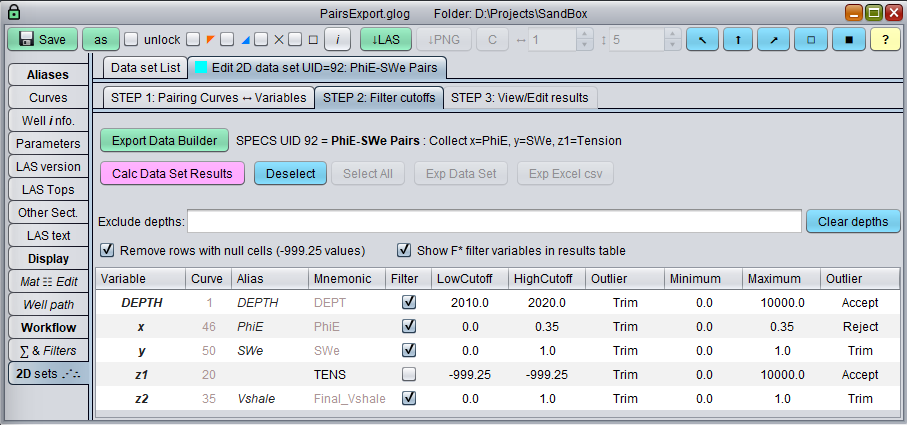
-
2022 December 14.
Build version Sha1 ID = 781A8C
Probabilistic computation of well log curves with envelope-uncertainty confidence-bands, are now available in our regular GUI work-flow of curve transformations:

-
2022 December 08.
Build version Sha1 ID = 5C239D
Curve log calibration and soft-ceiling compression are now available in its regular GUI workflow of curve transformations.
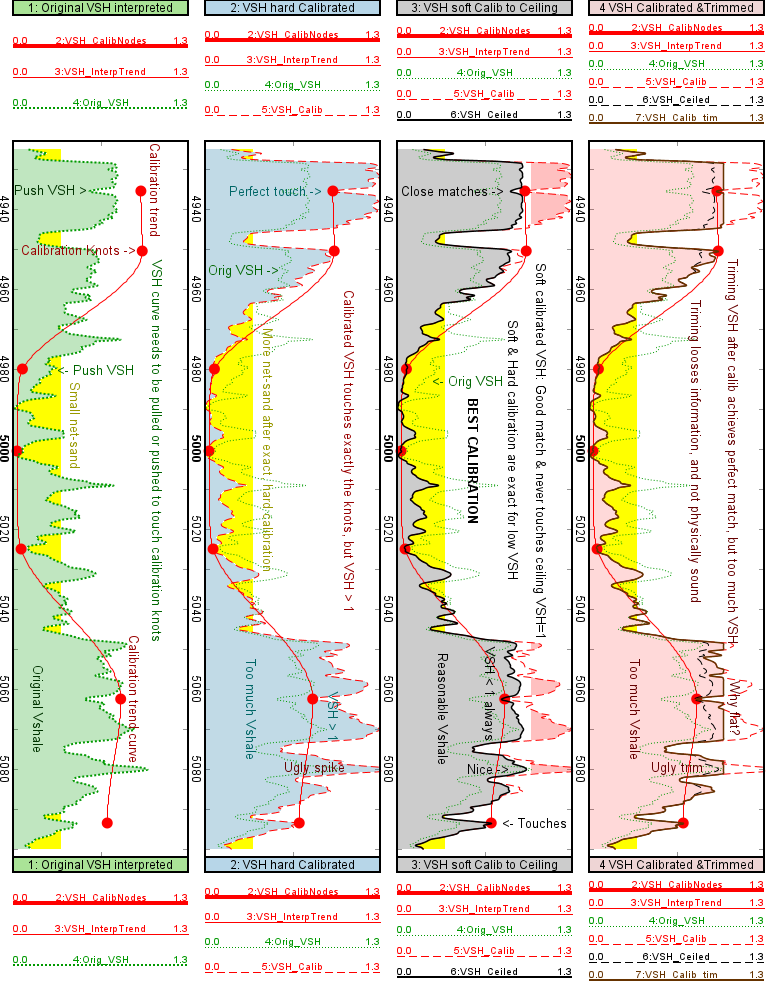
-
2022 November 24.
Build version Sha1 ID = 7EB6A2
GeolOil has been migrated to Java-19, while keeping legacy compatibility with Java-8 and beyond.
-
2022 October 09.
Build version Sha1 ID = 7C40FF
GeolOil provides out of the box, built-in functionality to perform irregular, proportional, arbitrarily depth deformations. You can stretch a curve that needs to be expanded or contracted to follow a user defined set of marker correlations (see advanced scripting) :

-
2022 October 06.
Build version Sha1 ID = BC2987
An improved Graphical User Interface (GUI) for the GeolOil Logging Scripting Language (GLS) has been released. This version shows more comprehensible error messages.
-
2022 September 29.
Build version Sha1 ID = 774F97
GeolOil incorporates multi-release incremental editions in the engine core. This is a quite convenient feature that allows the user to seamlessly switch between a Stable standard release, an LTS (Long Term Service) previous release, and a Beta release. All with the convenience of a single button click. No more need for risky & painful uninstalls and reinstalls to test a new upcoming edition.
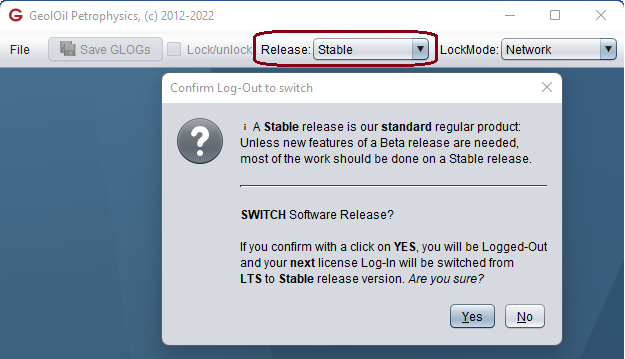
-
2022 August 26.
Build version Sha1 ID = E7C484
Improved auto-asignation of aliases after function pre-validations.
-
2022 March 23.
Build version Sha1 ID = 79B0E2
GeolOil has been verified for Java-18, while keeping legacy compatibility with 64 bits versions of Java-8 to Java-17.
-
2022 March 22.
Build version Sha1 ID = 8A62D5
GLOG file upload speed for large work-flows of more than 20 functions has been increased significantly, up to 2x or even 3x faster in most of the cases.
-
2022 January 21.
Build version Sha1 ID = C2F2E5
Multiwell Work-flows are now available in GeolOil. Once you have a common alias set for a collection of wells, pair the aliases with the mnemonic log curves, define a workflow as a sequence of functions and export it. Then any well can import the workflow and run it automatically. It may save hours of expert interpretation work as long as the wells are similar.
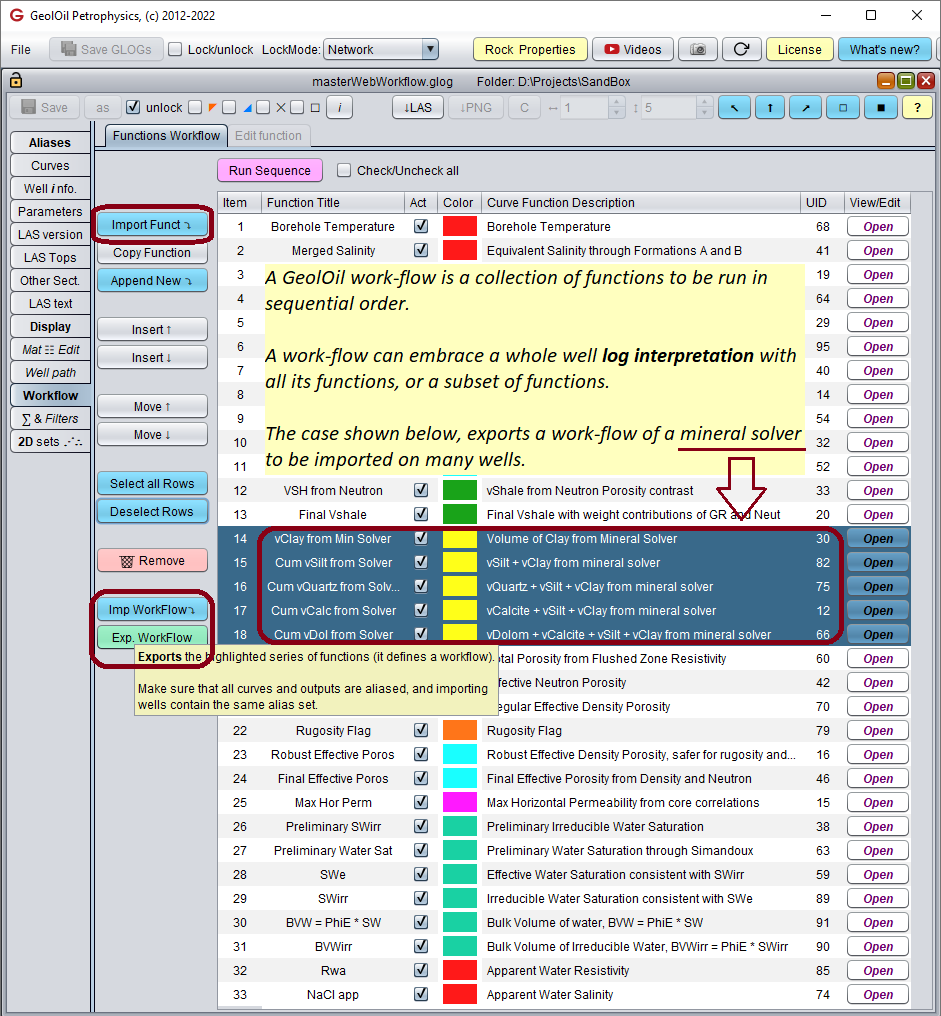
-
2022 January 17.
Build version Sha1 ID = E2336B
Multiwell Functions are now available in GeolOil. Once you have a common alias set for a collection of wells, assign the aliases to the mnemonic log curves and export a function. Then any well can import the function and run it automatically.

-
2022 January 07.
Build version Sha1 ID = 729C04
GeolOil is now adapted and recompiled with minor changes to run seamlessly on Windows-11 while keeping 100% legacy compatibility with Windows-10, MacOS, and Linux. Windows-11 allows to run GeolOil slightly faster as the OS yields more CPU time to foreground processes. -
2021 December 05.
Build version Sha1 ID = 1EDD77
Once the aliases for mnemonics are fully paired, GeolOil suggests suitable curve numbers to enter into input boxes of each equation work-flow. This new feature of the Alias Editor, is some sort of light-weight AI guesser for specific curve inputs.
The example shown below successfully suggested in green, the correct input curve numbers to estimate water saturation through the modified Simandoux water saturation. Each input box is filled with a back-ground color code indicating a suggestion state.

-
2021 October 02.
Build version Sha1 ID = 830147
GeolOil has been migrated to Java-17, while keeping legacy compatibility with 64 bits versions of Java-8 to Java-16. -
2021 August 02.
Major core build version Sha1 ID = 7D41C5
GeolOil provides an improved GUI interface to edit log tracks, fully coupled with the alias editor and display plot template savings.

-
2021 June 05.
Build version Sha1 ID = 00E7BD
GeolOil allows to "flatten" or "verticalize" well logs. New LAS file templates can be created either in MD, TVD, or TVDSS depth type spaces. Well logs originally defined for a standard MD space, can be projected onto vertical TVD or TVDSS space, not only for slanted and inclined wells, but also for horizontal wells on their invertible well path.
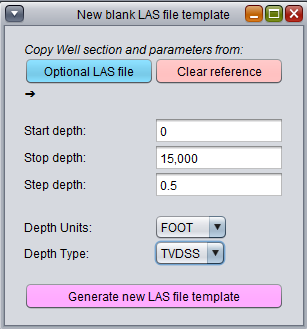
-
2021 March 25.
Build version Sha1 ID = 3FC17D
GeolOil is migrated to Java-16, while keeping legacy compatibility with 64 bits versions of Java from 8 to 15. -
2021 January 04.
Build version Sha1 ID = 1EC623
GeolOil 2021 Edition is released. This is our major release since our GLS Scripting language was launched in 2018. GeolOil 2021 main features are:
-
A fully editable alias system. It incorporates a fuzzy logic engine that automatically pairs
curve mnemonics with aliases. It has a high matching rate.
-
A display template system, with export and import capabilities for all tracks with its curves, colors and fillings.
- An automatic fuzzy logic plotting engine for LAS files. As soon as a new LAS file is open, GeolOil analyzes it and detects its curve mnemonics, pairs them with aliases, and produces a tentative log plot with tracks and curves:
-
A fully editable alias system. It incorporates a fuzzy logic engine that automatically pairs
curve mnemonics with aliases. It has a high matching rate.
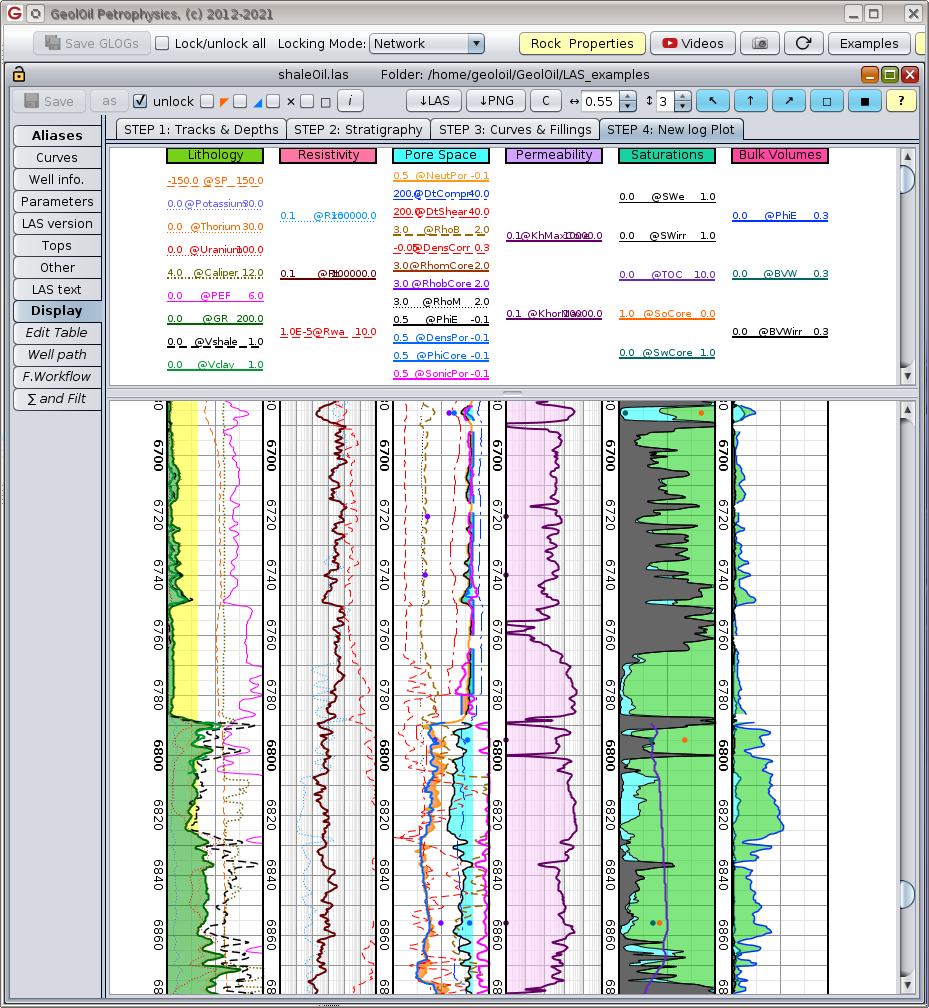
-
2020 October 25.
Build version Sha1 ID = 3BC172
A new, widely usable minimal mineral solver that runs only with Vshale and RHOM was added. After VSH is estimated, and the matrix density RHOM is estimated from the neutron to density contrast, this simple maximum entropy solver finds the volumes of clay, silt, quartz, calcite, and dolomite. Since curves for neutron porosity and bulk density are quite common, this mineral solver allows to explore and gives a clue of the dominant minerals in the matrix.

-
2020 October 13.
Build version Sha1 ID = 038A98
The SW water saturation ratio equation, now includes a correction for VSH shaliness. As expected, it yields smaller water saturations than Archie when VSH > 0. One more time, Archie over-estimates the amount of water, overlooking potential pay candidates. -
2020 October 12.
Build version Sha1 ID = B38EBE
Two new Vshale equations were added to the Functions Work-flow: The generalized Stieber equation, and its self adjusting C continuous curve parameter to calibrate VSH against an unbiased reference, like VSH from Neutron-Density. -
2020 October 01.
Build version Sha1 ID = 08220C
GeolOil is migrated to Java-15, while keeping legacy compatibility with Java-8/x64-bits, Java-9, Java-10, Java-11, Java-12, Java-13, and Java-14. -
2020 August 27.
Build version Sha1 ID = 9343A3
Improved Button-SpaceBar focus policy for a better user experience. -
2020 May 16.
Build version Sha1 ID = 3B0A18
Log plots are now displayed by default with a double scale: a regular MD scale, and a TVD-SS, TVD, & INC navigation scale in the first track. This is particularly useful for tilted and horizontal wells. The horizontal well below has an inclination of more than 90° (it is navigating upwards). Notice how TVD decreases while MD increases. The horizontal path is intersecting a tight "U" shape channel of quartz and calcite, with permeabilities in the order of nano-Darcies.
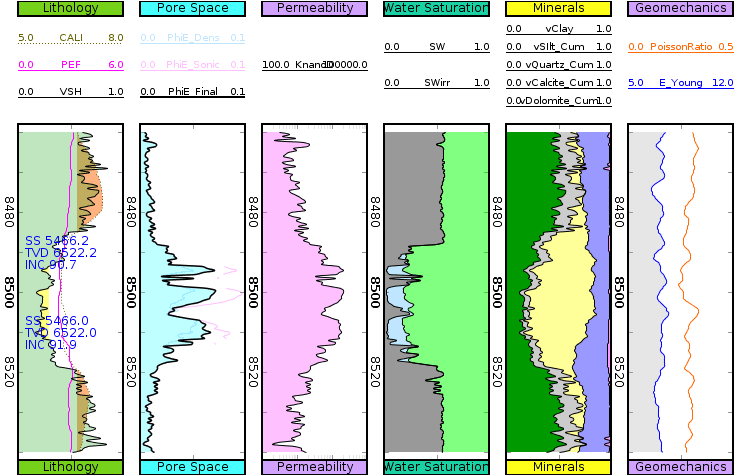
-
2020 April 01.
Build version Sha1 ID = D3CA79
GeolOil is migrated to Java-14, while keeping legacy compatibility with Java-8/x64-bits, Java-9, Java-10, Java-11, Java-12, and Java-13. -
2020 March 01.
Build version Sha1 ID = 940DCE
This release incorporates a downloadable GLOG learning example to estimate RHOM matrix density ρm using only log curves without any core laboratory measurements. An accurate RHOM estimate is needed to compute porosity, water saturation, and estimate a permeability correlation equation. -
2019 December 30.
Build version Sha1 ID = 211CFA
Icon flags to tag wells observing Gas-Oil-Contact (GOC), and Water-Oil-Contact (WOC). Minor improvements on Graphical User Design (GUI) buttons. Software model is called now 2020, with soon upcoming new specifications and features. Java-8 is deprecated and will be removed in a future release of GeolOil. It is still functional for backwards compatibility. Users are encouraged to migrate to JDK 13 or newer. -
2019 November 22.
Build version Sha1 ID = DCCECE
Three new method functions were added to estimate rock matrix density from easily available log data. They are the perfect companion to GeolOil's RHOM mineral solvers:
(25) In not too clayey rocks and no gas zones, RHOM is estimated by matching the behaviour of the curves Bulk Density and Neutron Porosity. It is similar to cloud cross-plots to detect main lithology, but its output is instead a whole RHOM curve varying with depth MD. The method even incorporates a correction for small shale content VSH to improve accuracy, and also aids to detect gas zones: As the method doesn't converge for gas, it may be a clue that suggests the presence of some free gas.
(23) & (24) When there is core porosity data, and either a bulk density or neutron porosity curve, RHOM is estimated but matching which grain density succeeds to replicate the porosity values measured on the core (make sure that the core is correctly shifted). These two functions provide useful reference estimates even when core grain density values are available, as in some cases values reported by the lab are no very reliable and may underestimate the correct RHOB.
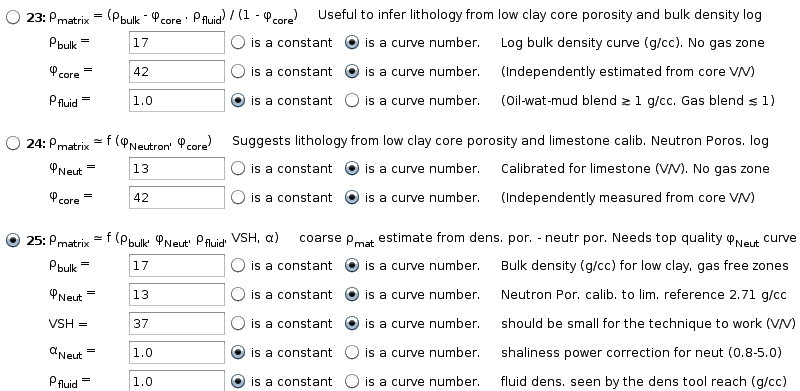
-
2019 October 03.
Build version Sha1 ID = FA55B9
GeolOil incorporates a server service to update an optional extra data-set of log examples. This service speeds up the learning of petrophysical concepts and log interpretations. -
2019 September 15.
Build version Sha1 ID = E69983
GeolOil is fully migrated to Java-13, while keeping legacy compatibility with Java-8/x64-bits, Java-9, Java-10, Java-11, and Java-12 -
2019 June 09.
Build version Sha1 ID = 0853A0
Schmoker equation to model TOC Total Organic Carbon in Oil Shales. -
2019 May 17.
Build version Sha1 ID = F563A6
Logic scripting capabilities were added with the incorporation of two indicator functions. This makes far easier to write short programs.

-
2019 April 27.
Build version Sha1 ID = 318EC40
New LAS 2.0 Section of Well Tops was added. The ~Tops section is not a standard default section in the CWLS year 2017 LAS 2.0 updated specs. However, it is permitted and increasingly popular. GeolOil now adds support for it. -
2019 April 15.
Build version Sha1 ID = 9DF605
Clastic mineral solver with components: quartz, silt, and clays illite, smectite, kaolinite, and chlorite. -
2019 April 07.
Build version Sha1 ID = 1230A0
Two new robust functions to estimate effective porosity even in cases of moderate bad boreholes with washouts. -
2019 April 03.
Build version Sha1 ID = AC6B02
GeolOil is fully migrated to Java-12, while keeping legacy compatibility with Java-8/x64-bits, Java-9, Java-10, and Java-11. -
2019 March 03.
Build version Sha1 ID = 6979A7
Kerogen deterministic solver with components: Clay, Silt, Lithics, and Kerogen. -
2019 February 23.
Build version Sha1 ID = 7748B5
Fuzzy logic seven components mineral solver: Clay, Silt, Quartz, Calcite, Dolomite, Anhydrite, and Salt. -
2019 January 27.
Build version Sha1 ID = E0EBCA
GeolOil is fully migrated to Java-11, while keeping legacy compatibility with Java-8/x64-bits. -
2018 September 28.
Build version Sha1 ID = A8DCB2
Added the correlation functions GeolOil-Holmes, and Holmes-Buckles to model Irreducible Water Saturation. -
2018 August 27.
Build version Sha1 ID = 07061B
File locking system for network environments. Several users can work concurrently on a same GLOG without risk of collisions. -
2018 July 30.
Build version Sha1 ID = 083941
Added correlation functions for Winland R35, RQI, FZI, and Pittman pore throat. -
2018 June 12.
Build version Sha1 ID = A04646
Hand typed functions editor: A simple and minimalist scripting language engine. -
2018 April 04.
Build version Sha1 ID = D24C11
Ionic Water Analysis: Equivalent NaCl water salinity and ions mEq electrical equilibrium from lab dissolved anions and cations PPM measurements of Sodium, Chloride, Calcium, Bicarbonate, Magnesium, Sulfate, Potassium, Nitrate, Iron, Carbonate, Ammonium, Bromide, Lithium, Iodine, Strontium, OH, Barium, Fluoride, and others. -
2018 Mar 02.
Build version Sha1 ID = FCB7CE
Import and export core data and curves from and to Excel .CSV -
2018 Feb 10.
Build version Sha1 ID = 3EA9F2
Seven more functions with correlations are equations were added: 3 correlations for Holmes-Buckles irreducible water saturation SWirr, and 4 equations to estimate water cut, and for relative & effective permeabilities to oil and water. Total amount of built-in equations and correlations increased from 77 to 84. -
2017 December 27.
Build version Sha1 ID = 3E2F1A
Pay Indicator index screening function added to the module of Sequential Petrophysical Functions and Correlations. Total amount of built-in equations and correlations increased from 74 to 77. -
2017 December 12.
Build version Sha1 ID = 9EB523
Unique multi-platform installer for Windows-PC, MacOS, and Linux. More accurate computation of 3D borehole trajectories. Improved estimation of water salinity from Rw at reservoir temperature. Sinusoidal unconformity shape added as a stratigraphic marker. Handling of log curves and fillings with color transparency alpha channels. -
2017 June 6.
Build version Sha1 ID = 5F352D
Natural Neighbors 3D interpolation for structural modeling, programmed on parallel threads. (Not be be confused with Nearest Neighbors) -
2017 May 29.
Build version Sha1 ID = 8369A3
Estimation of formation water resistivity Rw from micro-resistivity. -
2017 April 27.
Build version Sha1 ID = 5289FD
Estimation of Total Vertical Stress σv through the whole integration of the bulk density curve. -
2017 March 31.
Build version Sha1 ID = 295585
Petrophysical Mineral Solvers: Calcite-Dolomite-Anhydrite-Halite,
and Sandstone-Dolomite, using variable parameters.
-
2017 February 20.
Build version Sha1 ID = 71D08
Conversion of Neutron Porosity curves for variable continuous blend of rock matrices. -
2016 May 6.
Build version Sha1 ID = B043F5
Independent GUI buttons for log's vertical and horizontal zoom. Minor bug fixes and improved safety and security against hacker attacks. Improved stability of water saturation computation through capillary pressure height. -
2016 March 1.
Build version Sha1 ID = 4B541D
The first release for GeolOil in 2016 includes a new module: Sequential Petrophysical Functions. The user specifies key parameters to update log curves in a chained dependency computation. It is like specifying a short graphical algorithm. The release also adds new features to save all master GLOG files with a single click and more. -
2015 Oct 2.
Build version Sha1 ID = 7EA8B7
This release allows better functionality to shift core data and curves. New zone type called "Mark" puts streaks on the log plot by just keeping the mouse pressed and hitting the space bar. -
2015 Aug 1.
Build version Sha1 ID = 240381
This release allows to fully re-sample LAS files to any depth step resolution, start and stop depths: Create a new LAS file template with the desired specifications. Open one or several LAS files, export their desired curves. Import the curves into the new generated blank LAS file, that's all. The procedure is used to re-sample a LAS file itself, or to merge several dissimilar LAS files. -
2015 Mar 2.
Build version Sha1 ID = A5A641
This release allows to fully edit LAS files. The user not only can edit and change individual curve values at depth bins, but also can move and edit curve mnemonics and parameter sections. -
2015 Jan 22.
Build version Sha1 ID = 695246
Merging curves from different LAS files is easier than ever with our improved GUI design of the Curves Section tab. Just load a source LAS file, export the desired curves and import them into the target GLOG. New release also allows to edit individual curve cell values or remove whole curves from a LAS file. Optimized memory handling to manage even larger LAS files. Visual color range contrast of cell values on the "Edit Table" display is now adaptive and has been extended to its absolute maximum. -
2014 Oct 25.
Build version Sha1 ID = 458B25
Our new Well log upscaling module has been released. It enables a large diversity of upscalings: Intensive upscalings for porosity, water saturation and averages; Extensive upscalings, like Net-Pay, Net-Sand, hydrocarbon column, etc. The module also allows to estimate formation water resistivity by the Hingle method, and the Cementation exponent "m" by our exclusive GeolOil method. -
2014 Aug 31.
Build version Sha1 ID = C9C26D
Better log plot display. Now clicking on log with the right mouse button and dragging it, enables to measure the thickness of a zone. Minor bug fixes and improved stability. -
2014 May 16.
Build version Sha1 ID = AE6F2F
Improved logical arrangement of GUI buttons. The user can now save a GeolOil GLOG master file at any time, even before a log plot is made. New layout design allows more window space for plotting. -
2014 Mar 1.
Build version Sha1 ID = A8DA4D
The free GeolOil Logging Scripting (GLS) has a new instance overloaded method readFile to merge multi-column, irregularly depth spaced core lab data as new appended curves to a LAS file. This method is ideal to import core lab data from Excel spreadsheet files. Just export the Excel data cells as an ordinary space delimited plain text file and import it with a few GLS script lines. -
2014 Jan 23.
Version SHA1 ID = 362292
The free GeolOil Logging Scripting (GLS) now allows to merge LAS files. You may take one or more curves from a LAS file, other curves from other LAS files, and merge them all into another LAS file, even if each LAS file has different depth step resolution. -
2013 Nov 29.
Version SHA1 ID = 43F361
GeolOil now includes a new well TAB called: [Geometry Path]. With it, the user can load the well log vertical reference to the sea level (like Kelly Bushing KB or Derrick Floor DF), the flat-planar surface coordinates, the latitude and longitude, and the 3D well path Deviation Directional Survey trajectory file. Now with a single button click, GeolOil shows the exact well location spot on a Google Map for reference purposes.
New additional features to the GLS scripting language include the use of Akima Splines to offer an alternative interpolation method to natural splines to use digitized log curves, and irregular {(MD-digitized, MD-log)} non linear transformations to better match digitized Measured Depths to log real MDs. Well log digitizing services to produce digital LAS files from legacy original well raster images are available upon request. -
2013 Oct 19.
Version SHA1 ID = A0EB9B
LAS file plotter now includes 16 different zone types: Marker, Tag, Annotation, Label, Formation, Member, Bed, Completion. CoreTake, FluidTest, CoreTest, Facies, Unit, Layer, Interval and Zone. -
2013 Sep 16.
Version SHA1 ID = F5627C
Improved GLS language compiler. Better display of logged core measurements. Minor bug fixes. -
2013 Aug 26.
Version SHA1 ID = B116B6
3D Corner Point Geometry simulation grid module now computes cells connected to an aquifer. -
2013 Jul 3.
Version SHA1 ID = 6EAC11
GeolOil has released a digitally signed LAS viewer Micro-Edition: A tabular .LAS files reader bundled with the GLS scripting programming language. From July 2013, all GeolOil editions become digitally signed through a trusted certificate authority (CA), currently THAWTE, a subsidiary of SYMANTEC. This adds additional security features for all GeolOil Corporation software. -
2013 Jun 3.
Version SHA1 ID = 5C48C1
Handling of different stratigraphy definitions per well. -
2013 May 31.
Version SHA1 ID = A33819
Better arrangement of stratigraphy menu buttons. -
2013 Apr 03.
Version SHA1 ID = 7FA68A
Rock partition GLS recipe to split rock volumes into VSH, PHIE, SW and SH is now included into built-in demo dataset. -
2013 Mar 20.
Version SHA1 ID = 5E99AD
Minor bug fixes for LAS and GLS modules. -
2013 Feb 20.
Version SHA1 ID = 49F236
GeolOil has released the new technology GLS GeolOil Logging Scripting programming language for the Windows. -
2013 Jan 25.
Version SHA1 ID = CEC30E
GeolOil has released lite versions of the LAS log reader, viewer and plotter modules. -
2012 Dec 05.
Version SHA1 ID = D5BE84
GeolOil has released three new editions of the LAS well logs module: A completely free LAS log reader, a lite LAS log viewer, and the full featured LAS well log plotter. -
2012 Nov 06.
Version SHA1 ID = 2E317A
This release fixed minor bugs and improved the web help button. -
2012 Oct 04.
Version SHA1 ID = 8504FB
This version improved well log zone fillings display, both threshold and curve crossovers. -
2012 Sept 20
Version SHA1 ID = E8FCD8
This version enables copy of PROPERTY elements and ACTNUM between Corner Point Geometry Grids. -
2012 Aug 07
Version SHA1 ID = BB7175
This version improved Bezier polynomials computations. -
2012 Jul 25
Version SHA1 ID = DBFF78
Perforation date scheduling coupled with 3D cell navigation in the Corner Point Geometry Grid. -
2012 Jun 06
Version SHA1 ID = 8F8B57
Support for XML GeolOil well logs *.glog formatted files. (A proprietary format of GeolOil) -
2012 May 25
Version SHA1 ID = CC1294
Improved computation of 3D deviated wells trajectory path.
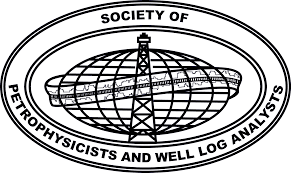 GeolOil is listed by the official
SPWLA software directory
GeolOil is listed by the official
SPWLA software directory
| |



|
|
|
© 2012-2026 GeolOil LLC. Please link or refer us under Creative Commons License CC-by-ND |




 TRAINING
TRAINING

 PAPERS
PAPERS
 REFERENCES
REFERENCES
 GET IN TOUCH
GET IN TOUCH

